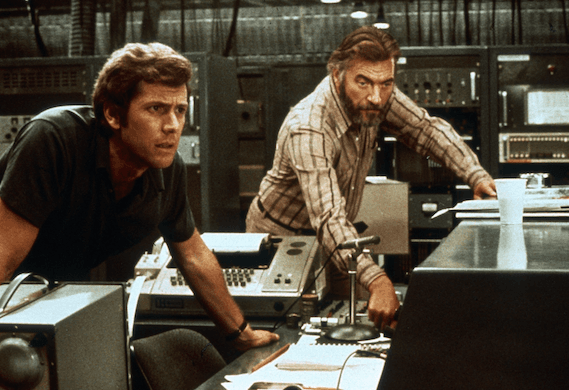Was Saul Bass the Real Director of ‘Psycho’?
It was Hitchcock, of course, but there is continuing speculation involving the true genius behind that movie’s most famous scene. You now have a chance to see the one film the graphic designer did direct.

‘Animal Farm: Ants’
Metrograph, 7 Ludlow St., Manhattan
Running until June 25
Has the jury come in yet as to who wrote Shakespeare’s plays? Although aware of the scuttlebutt surrounding the authorship of “King Lear,” “Hamlet” and related properties, I haven’t followed the controversy too closely. Mark Twain had his doubts, I know that much, as did Helen Keller and, wouldn’t you just know it, Sigmund Freud. The Bard of Avon has his own set of problems, as does his fellow countryman, Alfred Hitchcock.
Few people doubt the authenticity of Hitchcock’s vision even as they realize his metier is a collaborative art form. Hitch’s wife, Alma Reville, had a significant role in writing the screenplays for, among much else, “The 39 Steps,” “The Lady Vanishes,” and “Shadow of a Doubt.” As for the composer Bernard Herrmann: Try imagining “Vertigo” or “North by Northwest” without his accompanying soundtracks. Then, of course, there’s Saul Bass (1920-1996), the director of “Psycho.”
Okay, so the award-winning graphic designer didn’t direct “Psycho,” but there is continuing speculation involving the true genius behind that movie’s most famous scene. Bass’s gifts as a visual stylist not only encompassed movie posters and title sequences — the poster for “Vertigo” is, by my lights, still the gold standard — but storyboarding scenes for not inconsiderable pictures like “Spartacus” and the original “West Side Story.”
Hitchcock asked Bass to do the same for the sequence in which Marion Crane is killed in the shower. Did Bass helm the camera? This is what he had to say about directing: “It is hell. So complex, wearing, time-consuming. If anybody can help you, you want it. If somebody can relieve you of something, you’re grateful.” Bass would later state that he helped “lift” Hitchcock’s burdens while on the set. Janet Leigh acknowledged Bass’s contributions, but placed the directorial credit completely in Hitchcock’s hands.
All of which bears mention upon considering “Phase IV” (1974), the one-and-only feature directed by Bass. (He made a handful of shorts, winning an Oscar in 1968 for “Why Man Creates.”) The picture is included in “Animal Farm: Ants,” the Metrograph’s current “infestation of movies featuring our six-legged friends from the family Formicidae.” The other pictures include drive-in fare like “Them!” (1954) and “Empire of the Ants” (1977); “Microcosmos” (1996); and “Antz” (1998).
“Phase IV” is, shall we say, a creature unlike any other. Even as a teenage kid watching the picture at the local grindhouse, I realized it wasn’t your typical creature feature. Granted, all the hallmarks of what has come to be called “eco-horror” were in place: a cataclysmic event from beyond the stars; a locale far from the maddening crowd; strange events that scare the locals; and a pair of scientists, one sensible and the other not. Oh, and let’s not forget the young woman — yes, the love interest — seeking refuge from a world gone haywire.
Based on a short story by H.G. Wells, “Phase IV” posits a world in which ants of various species begin to share increasing intelligence, a collective gestalt, and a gift for architecture. A set of seven towering structures, kissing cousins of the monolith in Stanley Kubrick’s “2001: A Space Odyssey,” appear in the outreaches of the Arizona desert. Dr. Ernest D. Hubbs (Nigel Davenport) and fellow scientist James R. Lesko (Michael Murphy) set up a gleaming metal dome within this environment, a milieu packed to the hilt with computers, lab equipment, and, later, the aforementioned 16-year-old Kendra Eldridge (Lynne Frederick). What are the ants up to? Nothing good, as you might presume.
The film tanked at the box office for the same reasons it is remembered today — that is to say, the sheer quiddity of the enterprise, its cloistered, heady tone. Bass hired nature photographer Ken Middleham to film the ants, often in intensive close-ups, and the documentary nature of the footage gives “Phase IV” an unsettling credence.
The other smart hire on Bass’s part was Davenport, a British actor likely best known on these shores for his role as Lord Birkenhead in “Chariots of Fire.” Here he embodies the requisite mixture of obsession, mania, and diligence as the increasingly addled Dr. Hubbs.
As a director, Bass was no Hitchcock — just in case you were wondering — but he does bring a strong sense of know-how to the framing of scenes and the picture is, in the end, impressively pitiless in detailing humankind’s ineluctable hubris. Although decidedly uneven, “Phase IV” is worthy of one’s time and preferable to “Empire of the Ants,” a movie based on the same Wells story in which a pre-“Dynasty” Joan Collins is pursued by a bevy of oversized rubber monsters.
As for “Psycho”: Bass and Hitch have enough notches on their respective belts to hold their own. Sometimes it’s best to let sleeping auteurs lie.

